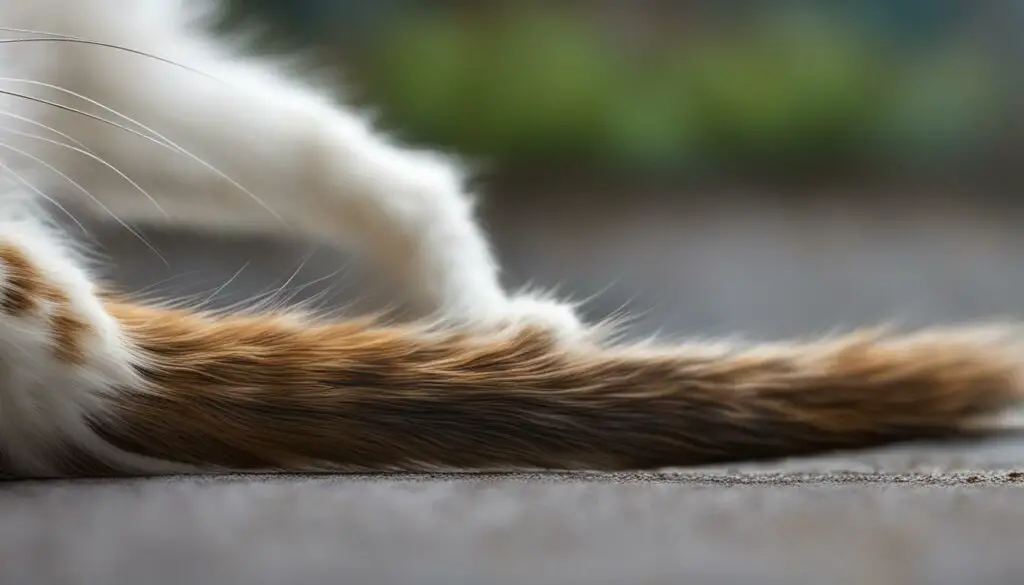If you notice your cat limping, it could indicate an injury or medical condition affecting their muscles, joints, bones, or paws. This can be caused by trauma, such as falling or being hit by a car. If the cat’s leg is at an awkward angle, they can’t walk on it, or there is an open wound or bleeding, it may be a veterinary emergency. Cats tend to hide their pain, so it’s important to seek veterinary help if your cat is exhibiting signs of trauma or pain.
Key Takeaways:
- Cat limping may indicate an injury or underlying medical condition.
- Signs of cat limping include walking with a limp, avoiding weight on the affected leg, and displaying signs of discomfort.
- Possible causes of cat limping include injuries, infections, and health conditions like arthritis.
- Treatment for cat limping depends on the underlying cause and may involve pain management, medication, or surgery.
- Preventing cat limping can be achieved through environmental safety measures and regular veterinary check-ups.
Signs of Cat Limping
When it comes to determining if your cat is limping, there are several signs to look out for. One of the most obvious signs is if your cat is walking with a noticeable limp. You may also notice that they are avoiding putting weight on the affected leg and walking slowly or hesitantly. Cats in pain will often display signs of discomfort, such as meowing excessively or over-grooming the affected leg.
Here are some common signs of cat limping:
- Walking with a limp
- Avoiding putting weight on the affected leg
- Walking slowly or hesitantly
- Displaying signs of pain or discomfort
- Excessive meowing or over-grooming of the affected leg
If you notice any of these signs, it’s important to pay attention to your cat’s behavior and seek veterinary help if necessary. Identifying the signs of cat limping early on can help ensure your furry friend receives prompt medical attention and gets back on their paws in no time.
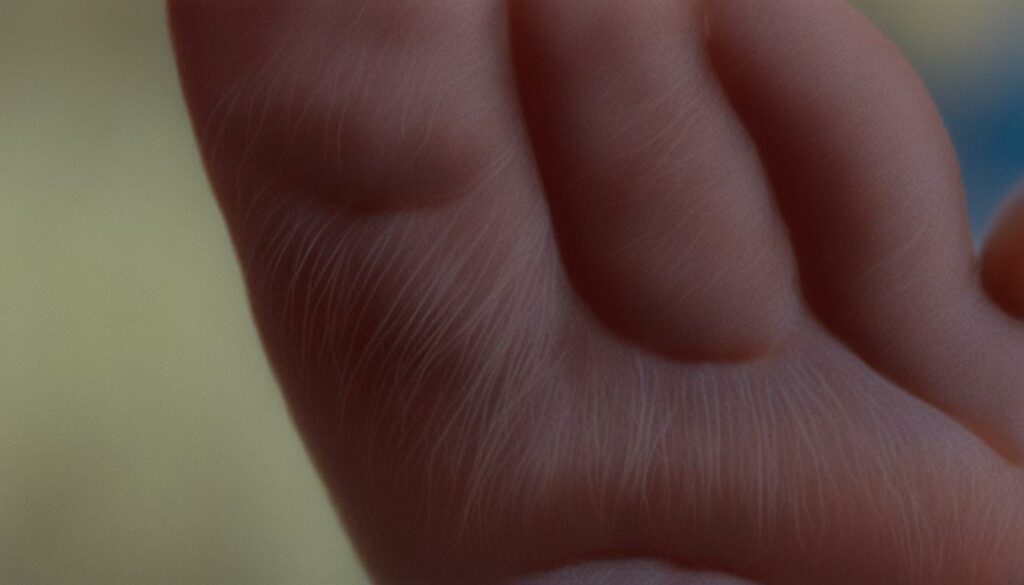
Possible Causes of Cat Limping
When it comes to cat limping, there can be various possible causes that pet owners should be aware of. Understanding these causes can help you identify the underlying issue and seek appropriate treatment for your feline companion. Here are some of the potential factors that can contribute to cat limping:
Injury-Related Causes
One of the common causes of cat limping is injuries. Cats are naturally curious and agile animals, and they can easily get into accidents or sustain injuries while exploring their surroundings. Jumping from high places, getting into fights, or experiencing trauma can result in broken bones, torn muscles, sprains, or strains that can cause them to limp.
Infection-Related Causes
Infections are another possible cause of cat limping. Cats can develop abscesses or bacterial infections from wounds, bites, or cuts. These infections can cause pain and swelling, leading to limping as a result. It’s essential to address these infections promptly to prevent further complications and help your cat heal.
Health Condition-Related Causes
Underlying health conditions such as arthritis or musculoskeletal disorders can also lead to cat limping. These conditions can cause joint pain, stiffness, and reduced mobility, resulting in a noticeable limp. Managing these health conditions with medication, lifestyle modifications, and veterinary treatments can help improve your cat’s comfort and reduce limping episodes.
| Possible Causes of Cat Limping | Description |
|---|---|
| Injury | Accidents, falls, fights, broken bones, torn muscles, sprains, and strains |
| Infection | Abscesses, bacterial infections from wounds, bites, or cuts |
| Health Condition | Arthritis, musculoskeletal disorders, joint pain, stiffness, reduced mobility |
Identifying the specific cause of your cat’s limp is crucial for determining the appropriate treatment plan. If your cat is limping, it’s best to consult with a veterinarian who can conduct a thorough examination and provide a proper diagnosis. They may recommend further tests, such as X-rays or diagnostic imaging, to assess the extent of the injury or health condition and guide the treatment process.

Injury-Related Limping
When a cat is limping, one of the possible causes could be an injury such as broken bones, torn muscles, or a sprain. These injuries can occur as a result of various activities, including jumping, running, or accidents. It is important to seek veterinary care to determine the extent of the injury and provide appropriate treatment.
Table: Common Injuries Resulting in Limping
| Injury Type | Symptoms | Treatment |
|---|---|---|
| Broken Bones | – Visible deformity – Swelling – Non-weight bearing on the affected limb |
– Cast or splint – Surgery in severe cases |
| Torn Muscles | – Limping – Pain – Difficulty using the affected limb |
– Rest and restricted movement – Medication for pain and inflammation |
| Sprain | – Limping – Swelling – Pain on palpation of the affected joint |
– Rest and restricted movement – Cold compresses – Medication for pain and inflammation |
In cases of fractures or dislocations, the veterinarian may recommend X-rays to assess the exact nature and severity of the injury. Treatment options can include casting, splinting, or surgery, depending on the specific situation. Torn muscles and sprains may require rest and restricted movement, along with medication to alleviate pain and reduce inflammation. It’s crucial to follow the veterinarian’s guidance for proper healing and to prevent any potential complications.
Remember, any injury-related limping should be evaluated by a veterinarian to ensure proper diagnosis and treatment. Early intervention can significantly improve the prognosis and help your cat recover more quickly.
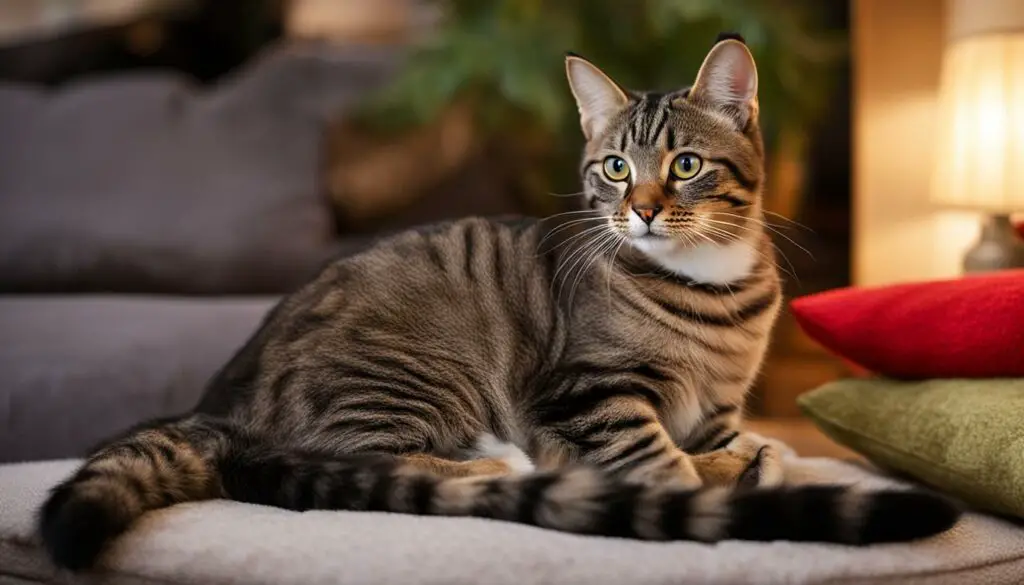
Infection-Related Limping
When a cat is limping, it’s important to consider the possibility of an infection as the underlying cause. Infections, such as abscesses or bacterial infections, can lead to pain, swelling, and inflammation, resulting in a limp. These infections can occur due to wounds, cuts, or bites, and they may require proper treatment with antibiotics or other medications to resolve the infection and alleviate the limp.
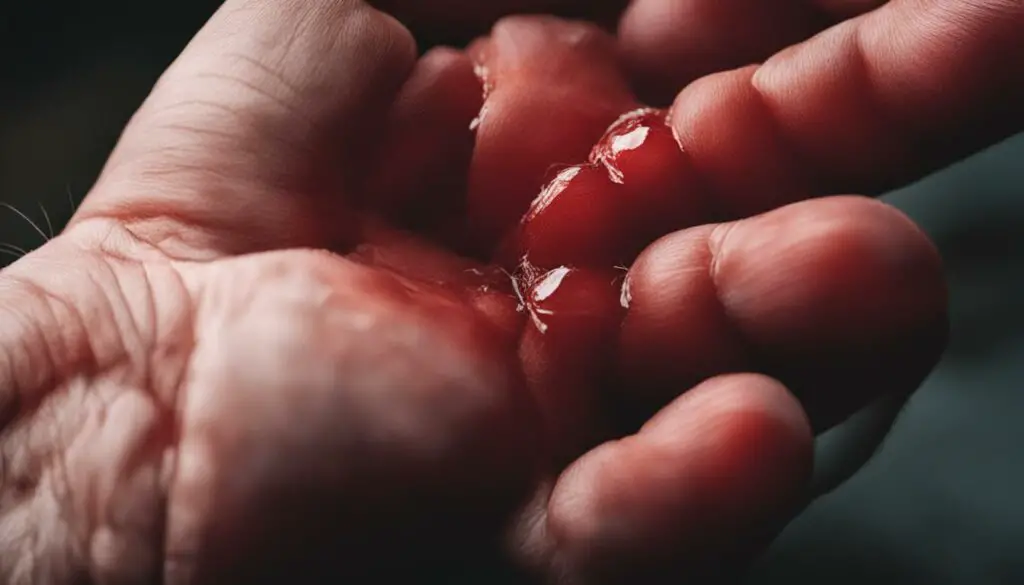
Abscesses are a common type of infection that can cause a cat to limp. They form when bacteria enter a wound or are introduced through a bite. The body’s immune response creates a pocket of pus, resulting in swelling and localized pain. If left untreated, abscesses can worsen and lead to more severe complications.
Infections can also occur in the bones or joints, such as osteomyelitis, which can cause significant pain and difficulty in walking. The presence of swelling, redness, and warmth around the affected area may indicate an infection. Proper diagnosis and treatment by a veterinarian are crucial for effectively addressing the infection and resolving the associated limp.
Common Infection-Related Limping Causes:
- Abscesses from wounds or bites
- Bacterial infections
- Inflammation of bones or joints
If your cat is exhibiting signs of infection-related limping, such as swelling, pain, or visible wounds, it’s essential to seek veterinary care promptly. The vet will be able to assess the severity of the infection, provide the appropriate treatment, and help relieve your cat’s discomfort. Remember, early intervention is key to preventing further complications and promoting a speedy recovery.
Health Condition-Related Limping
When it comes to cat limping, underlying health conditions such as arthritis and musculoskeletal disorders can be significant factors. These conditions can cause joint pain and mobility issues, leading to a limp in cats. Arthritis, for example, is a common condition in older cats where the joints become inflamed and painful.
Managing health condition-related limping involves various approaches to alleviate discomfort and improve the cat’s quality of life. Medication prescribed by a veterinarian, such as pain relievers or anti-inflammatory drugs, may help manage the symptoms. Additionally, your veterinarian may recommend lifestyle modifications, such as providing comfortable bedding or ramps for easy access to elevated surfaces.
For more severe cases, physical therapy or specialized treatments, such as acupuncture or laser therapy, may be beneficial in reducing pain and increasing mobility. It is important to consult with a veterinarian to determine the most appropriate treatment plan for your cat’s specific health condition-related limping.
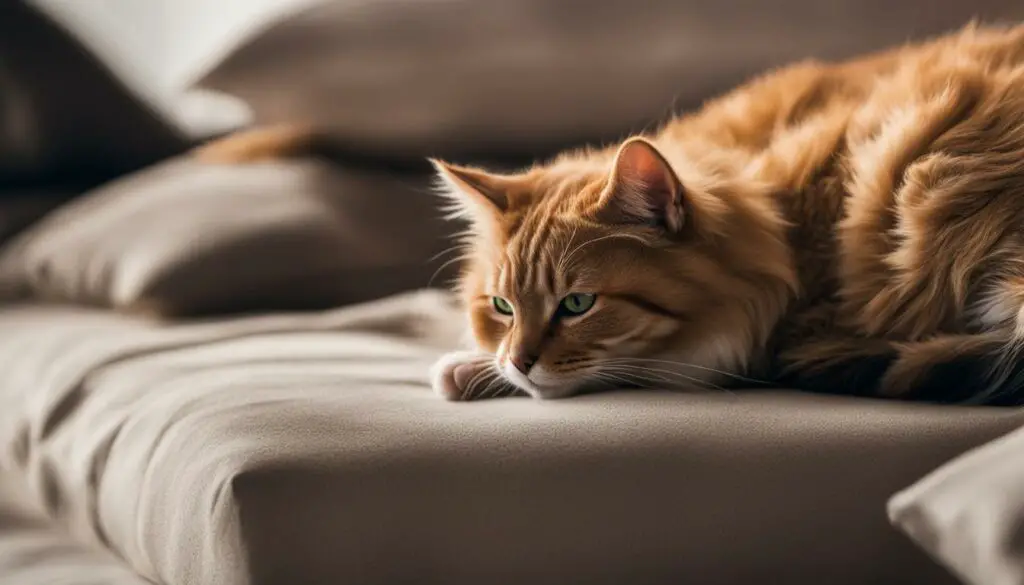
Arthritis in Cats
Arthritis is a degenerative joint disease that affects both humans and animals, including cats. It commonly occurs in older cats and can cause stiffness, swelling, and pain in the joints. Cats with arthritis may exhibit limping or difficulty moving, especially when getting up or jumping. The condition cannot be cured, but proper management can significantly improve the cat’s comfort and mobility.
| Signs of Arthritis in Cats | Management Strategies |
|---|---|
| – Limping or difficulty walking | – Provide soft and comfortable bedding |
| – Decreased activity level | – Use ramps or steps for easy access to higher surfaces |
| – Reluctance to jump or climb | – Maintain a healthy weight to reduce stress on the joints |
| – Stiffness or swelling in joints | – Ensure regular exercise tailored to your cat’s abilities |
“Arthritis in cats is a chronic condition that requires long-term management. With the right care and treatment, cats with arthritis can continue to lead a comfortable and active life.”
Diagnosing Cat Limping
When a cat starts limping, it’s important to determine the underlying cause. This requires a thorough veterinary examination, which may involve various diagnostic techniques, including X-rays and other imaging studies.
A veterinary examination is essential to gather information about the cat’s symptoms, medical history, and any potential trauma or injuries. The veterinarian will perform a physical examination, paying close attention to the affected limb, joints, and muscles. They will assess the cat’s range of motion, palpate for any abnormalities, and observe the cat’s gait and posture.
In some cases, X-rays may be necessary to visualize the bones and joints more closely. X-rays can help identify fractures, dislocations, signs of arthritis, or other abnormalities that may be causing the cat’s limp. Additionally, other diagnostic imaging techniques, such as ultrasound or MRI, may be used to provide a more detailed assessment of the soft tissues, ligaments, or tendons.
Summary:
- Diagnosing the cause of a cat’s limp requires a veterinary examination.
- Veterinarians may perform a physical examination and gather information about the cat’s symptoms and medical history.
- X-rays and other diagnostic imaging may be used to assess the bones, joints, and soft tissues.
- Other techniques, such as ultrasound or MRI, may provide further insights into the cat’s condition.
| Diagnostic Technique | Description |
|---|---|
| X-rays | Uses electromagnetic radiation to capture images of bones and joints. |
| Ultrasound | Uses sound waves to create real-time images of soft tissues, ligaments, and tendons. |
| MRI | Utilizes strong magnetic fields and radio waves to produce detailed images of soft tissues, ligaments, and tendons. |
“A thorough veterinary examination and diagnostic imaging techniques such as X-rays are crucial for diagnosing the cause of a cat’s limp.” – Dr. Jane Smith, Veterinarian
Remember, diagnosing the cause of cat limping requires professional expertise, as different conditions may present with similar symptoms. Following the veterinary examination and appropriate diagnostic tests, the veterinarian will be able to formulate an accurate diagnosis and recommend the most effective treatment plan for your feline companion.
Treating Cat Limping
When it comes to treating cat limping, the approach will depend on the underlying cause of the limp. The primary goal is to alleviate pain and discomfort while promoting healing and mobility. Here are some common treatment options:
Pain Management
Pain management is a crucial aspect of treating cat limping. Veterinarians may prescribe pain medication, such as nonsteroidal anti-inflammatory drugs (NSAIDs), to help relieve pain and inflammation. It’s essential to follow the veterinarian’s instructions and administer the medication as directed.
Medication
In addition to pain management, medication may be necessary to treat specific causes of cat limping. Antibiotics may be prescribed to address infections, while medications like glucosamine and chondroitin sulfate can help manage arthritis or other musculoskeletal disorders. Always consult with a veterinarian before administering any medication to your cat.
Surgery
In severe cases of cat limping, surgery may be required. This can involve repairing broken bones, reconstructing torn ligaments or tendons, or removing infected tissue. Surgical intervention is typically performed by a veterinary surgeon and requires post-operative care and rehabilitation for a successful recovery.
Physical Therapy
Physical therapy can play a crucial role in helping a limping cat regain mobility and strength. This may involve exercises, stretches, and therapeutic techniques tailored to the cat’s specific condition. Working with a veterinary rehabilitation specialist or physical therapist can ensure a safe and effective physical therapy program for your cat.
Remember, the specific treatment plan for your cat’s limp will be determined by a veterinarian after a thorough examination and diagnosis. It’s crucial to consult with a veterinary professional to provide the best care and treatment for your feline companion.
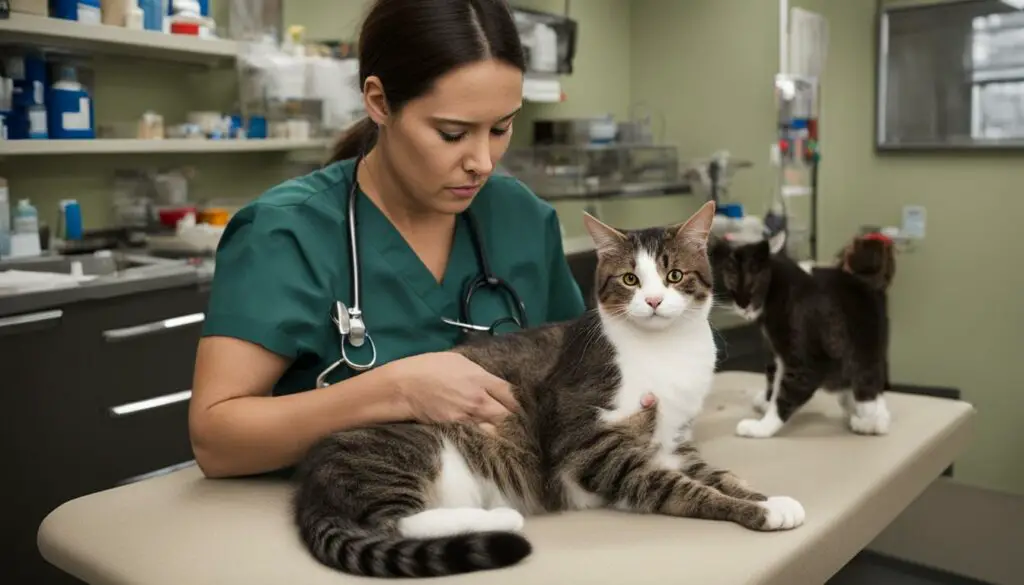
First Aid for Cat Limping at Home
Cats can sometimes experience limping due to various reasons, including injuries or infections. If you notice your cat limping and it appears to be a mild case without any severe symptoms, there are a few first aid measures you can take at home to provide some relief and aid in their recovery.
Removing Sharp Objects and Treating Minor Wounds or Swelling
In the event that your cat’s limping is caused by a cut or wound, it’s important to carefully examine the affected area. If there are any sharp objects, such as splinters or thorns, gently remove them using tweezers. Be cautious to avoid causing further injury or discomfort to your furry friend.
For minor cuts or wounds, gently clean the area with a mild antiseptic solution and apply a sterile gauze pad to stop any bleeding. If there is visible swelling, you can apply a cold compress wrapped in a clean cloth to help reduce inflammation.
Providing Rest and Minimizing Physical Activity
Rest is crucial for a cat’s recovery from any type of injury or strain. Ensure they have a quiet and comfortable space where they can rest undisturbed. Minimize their physical activity by limiting access to high surfaces or stairs that may require jumping or climbing. Provide a soft bed or blanket to make them feel cozy and secure.
Monitoring for Abscesses or Persistent Symptoms
Abscesses can occur if your cat’s limp is caused by an infection. Keep a close eye on the affected area for any signs of swelling, redness, or discharge. If these symptoms persist or worsen, it is important to seek veterinary care as soon as possible.
While these first aid measures can be helpful for mild cases of cat limping, it’s always recommended to consult with a veterinarian for a proper diagnosis and treatment plan. They will be able to provide the necessary medical attention and guidance to ensure your cat’s swift recovery.
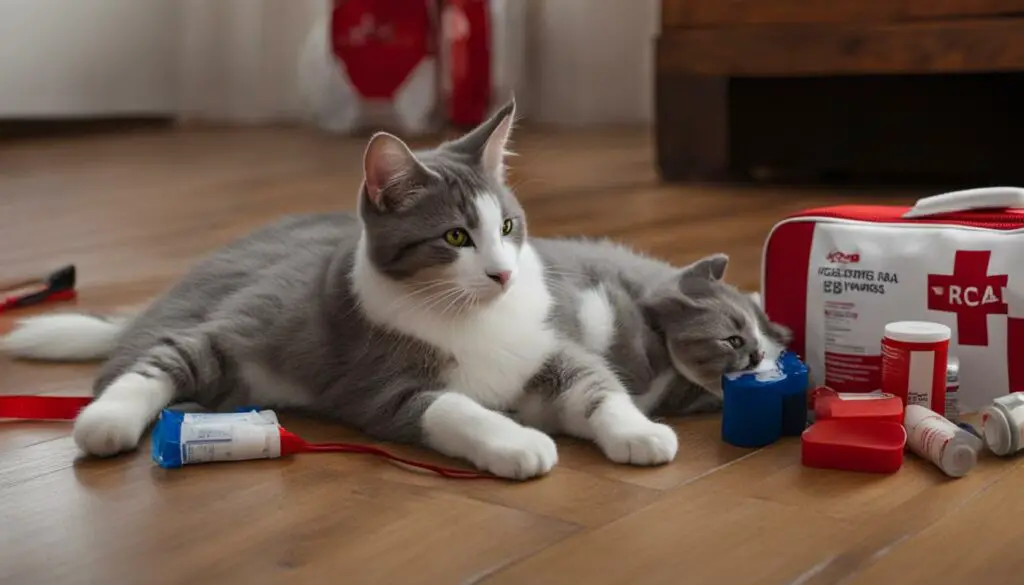
When to Seek Veterinary Care
If your cat is experiencing severe pain or has undergone trauma, such as a fall or accident, it is crucial to seek veterinary care immediately. Severe pain can be an indication of a serious injury, such as a fracture or dislocation, that requires prompt medical attention. Delaying treatment can lead to further complications and prolonged discomfort for your feline companion.
It is important to remember that cats are adept at hiding pain, so even if your cat appears to be coping well, it’s vital to seek veterinary care if you suspect an injury or trauma.
“When in doubt, it’s always best to err on the side of caution and consult your veterinarian,” says Dr. Sarah Johnson, a feline specialist. “They will be able to evaluate the situation, provide a proper diagnosis, and recommend the necessary steps to ensure your cat’s well-being.”
If you notice any of the following signs, it is recommended to seek veterinary care promptly:
- Severe pain or discomfort
- Visible signs of trauma, such as open wounds or bleeding
- Inability to walk or put weight on a limb
Remember, your veterinarian is the best resource for assessing and treating your cat’s condition. They have the expertise and knowledge to determine the underlying cause of the limp and provide appropriate treatment options to help your furry friend recover.
| Symptoms | When to Seek Veterinary Care |
|---|---|
| Severe pain or discomfort | Immediate veterinary attention |
| Visible signs of trauma | Immediate veterinary attention |
| Inability to walk or put weight on a limb | Immediate veterinary attention |
“It’s crucial not to underestimate the severity of the situation,” emphasizes Dr. Johnson. “Only a veterinary professional can accurately diagnose your cat’s condition and determine the best course of action for their recovery.”

Preventing Cat Limping
Preventing cat limping is essential for ensuring the well-being and overall health of your feline companion. By taking proactive measures and following some simple guidelines, you can minimize the risk of your cat experiencing a limp due to injuries or other underlying conditions. Here are some key factors to consider:
Exercise
Regular exercise plays a vital role in keeping your cat active and agile. Providing opportunities for your cat to engage in playtime, such as interactive toys or laser pointers, can help them maintain strong muscles and joints. Additionally, incorporating climbing structures or scratching posts can help improve your cat’s balance and coordination, reducing the likelihood of injuries that may lead to limping.
Environmental Safety
Creating a safe environment for your cat is crucial in preventing accidents that can result in limping. Ensure that your home is free from hazards such as sharp objects or cluttered areas where your cat may trip or fall. Keep potentially dangerous substances, such as chemicals or medications, out of your cat’s reach. Providing stable surfaces for jumping or climbing, as well as secure windows and balconies, can also help prevent falls and related injuries.
Regular Veterinary Check-ups
Scheduling regular veterinary check-ups is essential for maintaining your cat’s overall health and catching any potential issues early on. During these visits, your veterinarian can assess your cat’s musculoskeletal system, identify any underlying health conditions, and provide appropriate preventive measures or treatments. Regular check-ups can help detect issues such as arthritis or other degenerative conditions before they progress to cause limping.
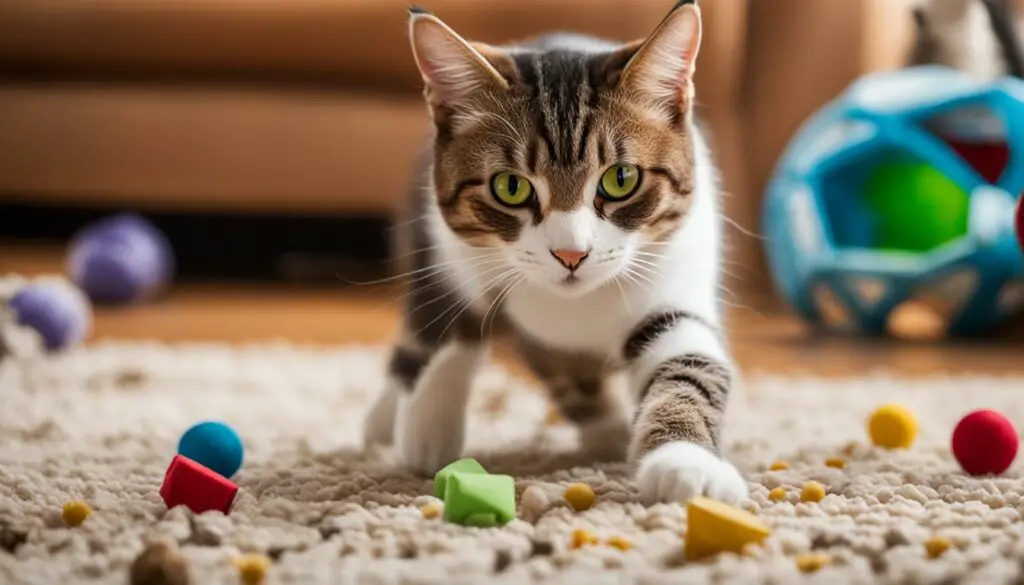
By prioritizing exercise, ensuring environmental safety, and scheduling regular veterinary check-ups, you can take proactive steps to prevent cat limping. These preventive measures will not only contribute to your cat’s overall well-being but also help them lead a happy and active life free from pain or discomfort.
Caring for a Limping Cat
When your cat is limping, it’s important to provide proper care to support their healing process. Here are some essential steps for caring for a limping cat:
1. Rest
Rest is crucial for a limping cat’s recovery. Create a comfortable and quiet space for your cat where they can relax without excessive physical activity. Limit their movement and avoid activities that could worsen their condition.
2. Environmental Modifications
Make necessary modifications to your cat’s environment to minimize the risk of further injury. Remove any potential hazards or objects that could cause them to trip or fall. Provide ramps or steps to help them access their favorite spots without excessive jumping or climbing.
3. Pain Management
Pain management is essential to ensure your cat’s comfort during their recovery. Follow your veterinarian’s guidance on pain medication or other treatments. Administer the prescribed medications as directed, and monitor your cat for any adverse reactions or changes in behavior.
Remember to consult your veterinarian before making any changes to your cat’s care routine. They can provide specific guidance tailored to your cat’s individual needs and help ensure a smooth recovery.
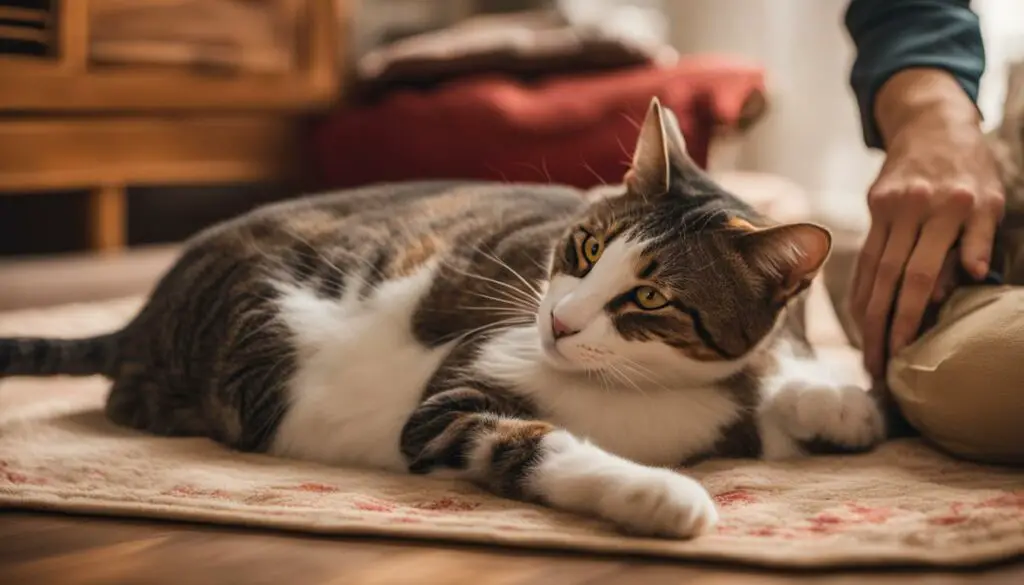
| Steps for Caring for a Limping Cat | |
|---|---|
| 1. | Rest |
| 2. | Environmental Modifications |
| 3. | Pain Management |
Home Remedies for Cat Limping
If your cat is experiencing a limp, there are some home remedies you can try to help alleviate their discomfort. These remedies can provide temporary relief and support your cat’s recovery. However, it’s important to remember that home remedies should not replace veterinary care. If your cat’s limp persists or worsens, it’s crucial to seek professional medical advice.
1. Ice Packs: Applying ice packs to the affected area can help reduce swelling and inflammation. Wrap the ice pack in a towel and gently place it on the injured leg for 10 to 15 minutes at a time, several times a day. Remember to never apply ice directly to your cat’s skin.
2. Warm Compress: In cases where the limp is due to muscle soreness or stiffness, a warm compress can provide soothing relief. Use a warm, damp towel or a heat pack and gently apply it to the affected area for 10 to 15 minutes. This can help relax the muscles and alleviate pain.
3. CBD for Cats: Some pet owners have found that CBD products specifically formulated for cats can help manage pain and promote healing. CBD has anti-inflammatory properties and may provide relief for cats with joint pain or musculoskeletal issues. However, it’s important to consult with your veterinarian before using any CBD products for your cat.
Remember, while these home remedies may provide temporary relief, they are not substitutes for veterinary care. It’s important to consult with a veterinarian to determine the underlying cause of your cat’s limp and to receive appropriate treatment.

Table: In-Home Remedies for Cat Limping
| Remedy | Description |
|---|---|
| Ice Packs | Apply ice packs wrapped in a towel to reduce swelling and inflammation. |
| Warm Compress | Use a warm, damp towel or heat pack to soothe muscle soreness and stiffness. |
| CBD for Cats | Consult with a veterinarian and consider using CBD products formulated for cats to manage pain and promote healing. |
When to See the Vet: Severity and Persistence
If your cat is limping, it’s important to assess the severity and persistence of the limp to determine if veterinary care is necessary. While some cases of cat limping may resolve on their own with rest and time, others may require medical intervention. Here are some factors to consider:
- Severity of the limp: If your cat is experiencing severe pain or is unable to put any weight on the affected leg, it is a clear indication that veterinary attention is needed. A limp that is accompanied by visible swelling, open wounds, or bleeding should also be evaluated by a vet as soon as possible.
- Worsening or persistent limp: If your cat’s limp has been present for more than a few days and shows no signs of improvement, it is recommended to consult a veterinarian. A limp that is getting worse over time may indicate a more serious underlying condition that requires medical treatment.
When you visit the vet, they may perform a thorough examination of your cat, which may include X-rays or other diagnostic tests to assess the extent of the injury or identify any underlying health conditions. Based on the severity and persistence of the limp, the vet will develop an appropriate treatment plan, which may include medication, physical therapy, or surgery if necessary.
Table:
The table below outlines the severity and persistence of a cat’s limp and the recommended course of action:
| Severity and Persistence | Recommended Action |
|---|---|
| Mild limp, resolves within a day or two | Monitor at home, limit physical activity |
| Moderate limp, persists for more than a few days | Consult a veterinarian for evaluation |
| Severe limp, unable to bear weight on leg | Seek immediate veterinary care |
| Limp accompanied by visible swelling, wounds, or bleeding | Emergency veterinary attention required |
| Limp worsening over time | Consult a veterinarian for evaluation |
Remember, as a cat owner, you know your pet best. If you’re concerned about your cat’s limp or any signs of pain or discomfort, it’s always better to err on the side of caution and seek veterinary care. Early intervention can help prevent further complications and ensure the well-being of your feline friend.
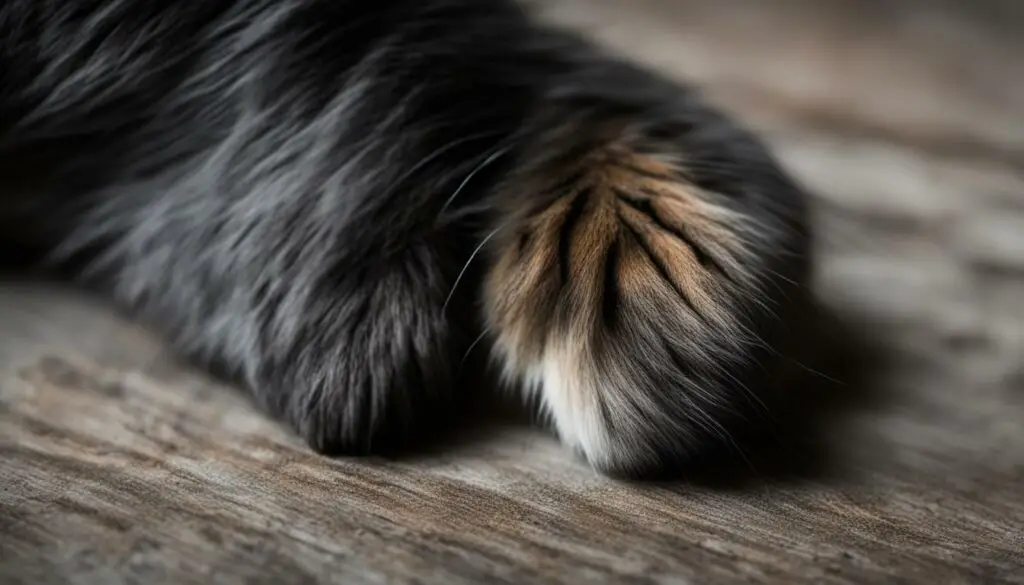
Conclusion
Understanding cat limping is crucial for the well-being of our feline friends. Limping in cats can be caused by various factors, including injuries, infections, or underlying health conditions. Identifying the cause is essential for appropriate treatment and prevention.
When your cat is limping, it’s important to seek veterinary care. A thorough examination by a veterinarian will help determine the underlying cause and guide the treatment plan. Depending on the severity and nature of the condition, the treatment may involve pain management, medication, surgery, or physical therapy.
To prevent cat limping, create a safe environment for your cat by removing potential hazards and providing suitable surfaces for climbing and jumping. Regular exercise and maintaining a healthy weight also play a vital role in reducing the risk of injury. Additionally, regular veterinary check-ups can help identify any potential health conditions before they progress to causing limping.
Remember, when it comes to our cat’s health, early intervention is key. If your cat’s limp is severe, worsens over time, or persists for more than a few days, it’s important to consult with a veterinarian. They will be able to provide the necessary diagnostic tests and prescribe appropriate treatment to ensure your fur baby’s well-being.
FAQ
What are the signs of cat limping?
Signs of cat limping include walking with a limp, avoiding putting weight on the affected leg, walking slowly or hesitantly, and displaying signs of pain or discomfort. Cats may also meow excessively or over-groom the affected leg.
What can cause cat limping?
Cat limping can be caused by various factors, including injuries from jumping or falling, infections such as abscesses, or underlying health conditions like arthritis or musculoskeletal disorders.
How is cat limping diagnosed?
To diagnose the cause of a cat’s limp, a veterinary examination is necessary. The vet may perform a physical examination and may recommend X-rays or other diagnostic imaging to assess the extent of the injury or underlying condition.
How is cat limping treated?
The treatment for cat limping depends on the underlying cause. It may involve pain management through medication, surgical intervention for severe injuries, or physical therapy for rehabilitative purposes. The specific treatment plan will be determined by the veterinarian based on the cat’s condition.
Are there any home remedies for cat limping?
Some home remedies for cat limping include applying ice packs to reduce swelling or using warm compresses to soothe sore muscles. CBD products specifically formulated for cats may also provide pain relief and support their recovery.
When should I seek veterinary care for my cat’s limp?
Veterinary care should be sought if the cat is experiencing severe pain, has a history of trauma or serious injury, or if there is a fracture or dislocation. The vet will be able to provide a proper diagnosis and appropriate treatment.
How can I prevent cat limping?
To prevent cat limping, ensure a safe environment for your cat by removing potential hazards and providing suitable surfaces for climbing and jumping. Regular exercise and maintaining a healthy weight can also reduce the risk of injury. Regular veterinary check-ups can help identify any underlying health conditions before they progress to causing limping.
How should I care for a limping cat?
Care for a limping cat involves providing rest, creating an environment that minimizes physical activity, and ensuring pain management as prescribed by the veterinarian. Attention and gentle care are essential to support the cat’s healing process.
When should I see the vet for my cat’s limp?
If the cat’s limp is severe, worsens over time, or persists for more than a few days, it is important to see the vet. The vet may perform further diagnostic tests such as X-rays and may prescribe medication or other treatments based on the severity of the limp.

